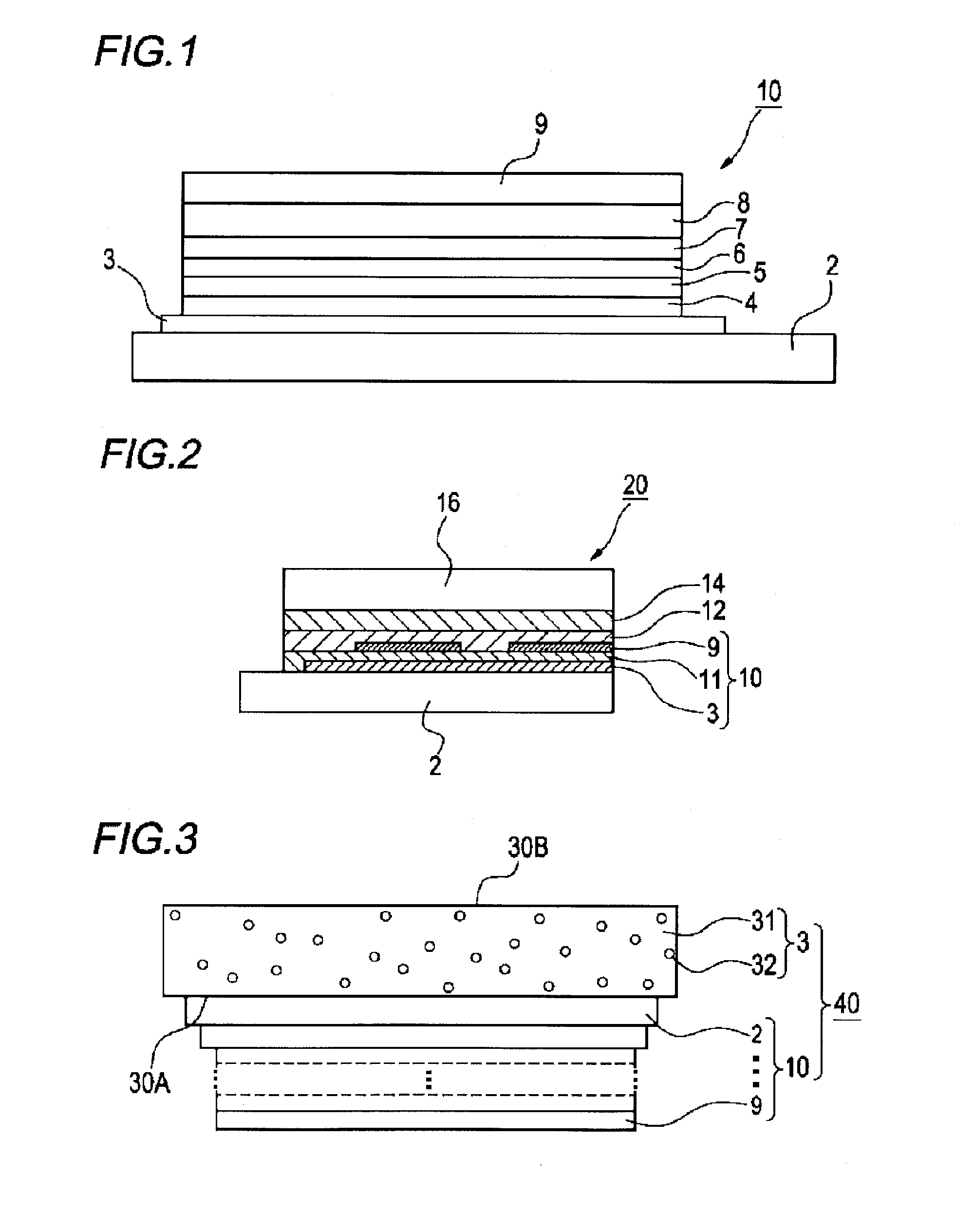Organic electroluminescent device
a technology of electroluminescent devices and electroluminescent devices, which is applied in the direction of thermoelectric devices, organic chemistry, platinum organic compounds, etc., can solve the problems of increasing the drive voltage, reducing the power efficiency per amount of luminescence, and inevitably reducing durability of the device, so as to achieve excellent emission properties and reduce the drive voltage
- Summary
- Abstract
- Description
- Claims
- Application Information
AI Technical Summary
Benefits of technology
Problems solved by technology
Method used
Image
Examples
synthesis example 1
[0280]The following Exemplified compound 1 was synthesized.
[0281]A THF solution of Compound a (20.0 g, 56.2 mmol, 1.0 equivalent) was cooled to −78° C. in a nitrogen atmosphere and while stirring, the resulting solution was added dropwise to butyllithium (36.9 mL, 59.0 mmol, 1.05 equivalents) gradually. After stirring for 30 minutes as was, the resulting mixture was raised to room temperature while feeding the mixture with a carbon dioxide gas that was caused to pass through a calcium chloride tube. Then, a saturated aqueous solution of ammonium chloride was added to the reaction mixture, followed by extraction with ethyl acetate. The organic phases were combined, dried, and concentrated. The residue thus obtained was purified by a silica gel column to obtain 6.99 g (yield: 82%) of Compound b as a mixture with the raw materials.
[0282]A mixture composed of Compound b (7.2 g, 8.6 mmol, 1.0 equivalent), 2,6-difluoropyridyl-3-boric acid (5.3 g, 33.6 mmol, 1.5 equivalents), palladium ace...
synthesis example 2
[0305]The following Exemplified compound 2 was synthesized.
[0306]Compound c (1.0 g, 2.5 mmol, 1.0 equivalent) was dissolved in thionyl chloride (10 mL) and the resulting solution was heated and refluxed for 1.5 hours. After the reaction mixture was allowed to cool, the thionyl chloride was distilled off. The residue thus obtained was dissolved in methylene chloride (10 mL), followed by cooling to 0° C. Methanesulfonylamine (285 mg, 3.0 mmol, 1.2 equivalents) was added in portions to the resulting solution and the mixture was raised to room temperature. Water was added to the reaction mixture, followed by extraction with ethyl acetate. The organic phases were combined, dried, and concentrated. The residue thus obtained was purified by a column to obtain 980 mg (90%) of Compound d as a viscous liquid.
[0307]Platinum dichloride (325 mg, 1.22 mmol, 1.0 equivalent) and Compound d (530 mg, 1.22 mmol, 1.0 equivalent) were stirred in benzonitrile (10 mL) for 1.5 hours in a nitrogen atmospher...
synthesis example 3
[0310]The following Exemplified compound 3 was synthesized.
[0311]A triethylamine solution (10 mL) of Compound a (6.0 g, 16.8 mmol, 1.0 equivalent), ethyl phenyl hypophosphite (2.6 mL, 16.8 mmol, 1.0 equivalent), and tetrakistriphenylphosphine palladium (970 mg, 0.84 mmol, 0.05 equivalent) was heated for 1.5 hours at 100° C. After the reaction mixture was allowed to cool, a saturated aqueous solution of ammonium chloride was added to the reaction mixture, followed by extraction with ethyl acetate. The organic phases were combined, dried, and concentrated. The residue thus obtained was purified by a column to obtain 4.0 g (53%) of Compound e as a viscous liquid.
[0312]A mixture composed of Compound e (3.8 g, 8.5 mmol, 1.0 equivalent), 2,6-difluoropyridyl-3-boric acid (2.0 g, 12.8 mmol, 1.5 equivalents), palladium acetate (95 mg, 0.42 mmol, 5.0 mol %), triphenylphosphine (445 mg, 1.7 mmol, 0.2 equivalent), sodium carbonate (4.5 g, 43.0 mmol, 5.0 equivalents), dimethoxyethane (70.0 mL), ...
PUM
| Property | Measurement | Unit |
|---|---|---|
| thickness | aaaaa | aaaaa |
| light transmittance | aaaaa | aaaaa |
| light transmittance | aaaaa | aaaaa |
Abstract
Description
Claims
Application Information
 Login to View More
Login to View More - R&D
- Intellectual Property
- Life Sciences
- Materials
- Tech Scout
- Unparalleled Data Quality
- Higher Quality Content
- 60% Fewer Hallucinations
Browse by: Latest US Patents, China's latest patents, Technical Efficacy Thesaurus, Application Domain, Technology Topic, Popular Technical Reports.
© 2025 PatSnap. All rights reserved.Legal|Privacy policy|Modern Slavery Act Transparency Statement|Sitemap|About US| Contact US: help@patsnap.com



